From Ink to Pixels: European graphic novels-turned-video-game pioneers, Part 2 – Druuna: Morbus Gravis
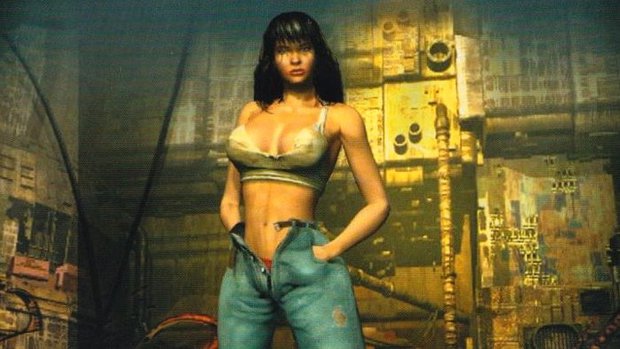
- 0 Comments
When it comes to video game adaptations, for many people the terms ‘comic book’ and ‘superheroes’ are largely interchangeable. There have been some notable exceptions over the years, however, beginning in the early 2000s when some of Europe’s most celebrated non-superhero comic books were adapted with input from their original creators – some more successfully than others. Continuing my earlier examination of Salammbô: Battle for Carthage, this multi-part article series explores the second of three pioneering games that stand out in my personal experience as the most interesting interpretations of their source material. They may not have left much of a lasting impression in their own right, but they helped blaze a trail for other comic book franchises to succeed where their predecessors did not.
Druuna: Morbus Gravis
Inspiration can come at the most unexpected of times. In the early 1980s, Paolo Eleuteri Serpieri was primarily known for his work on Western comics. Serpieri had been fascinated with stories of the American West ever since he was a child, and had made a name for himself thanks to his dramatic and intricately detailed renditions of the frontier in the Italian comic publication LancioStory.
But Serpieri had ideas for a new character outside of Westerns, about a shapely protagonist who would get into all manner of comedic and sexy conundrums, set against a science fiction backdrop. He recalled his inspiration for the character in his 1993 book Druuna X, stating:
When I conceived Druuna, she was very different from the women we know today. I had, in fact, wanted to draw a very erotic short story in a highly caricatured style, about a voluptuous, curvaceous woman. That’s all. I was at the beach in Ostie, in Italy, one day when it was completely deserted. As I watched, a naked woman splashed out of the waves. Her body glistened with golden droplets that sparkled under the sun… The woman I had been looking for, for so long, was there before me, in all her naked splendor… At that precise moment in time, I had no idea that I would create an almost unending saga from that one vision.
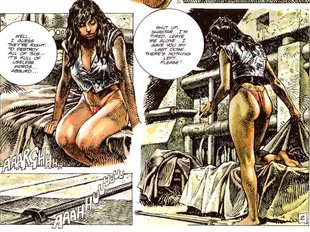
First released in the monthly French magazine Charlie in 1985, followed by translations into other languages thereafter (Heavy Metal published the English translation in 1986), Morbus Gravis introduced audiences to Druuna, who lives in a post-apocalyptic world ravaged by horrific disease. There an elite group known as the Priests holds a ruined city captive under martial law. Citizens must attend clinics to receive serum, ensuring their biological purity. Those stricken with the illness are cast out of the city, abandoned and left to mutate into horrific monsters.
Split into two volumes, Morbus Gravis I and II are disturbing yet undeniably beautiful works. The world is on the brink of collapse, and people are reduced to their most primal and aggressive states. Yet Druuna acts as a vessel of hope, helping to discover the truth behind the Priests and the city they control, and ultimately sever their bonds of tyranny.
Mutations
Due to the series’ graphic nature, Serpieri stated in a 2002 interview in Skrit that many of the pitches he received to bring Druuna to the screen were purely sexual in nature, admitting with some annoyance that "I even got producers coming to see me at the time, wishing to make erotic films with Druuna, with ideas, erotic subjects, even hard porn material, and I refused the lot."

The project to adapt Morbus Gravis into a game began in 1998, with Druuna: Morbus Gravis ultimately being released just before the end of 2001. Though an adaptation of the first entry in the comic series, Morbus Gravis I, the setting is loosely based on the series’ fourth entry, Creatura. Here Druuna is in a comatose state aboard a spacecraft. Confined to the ship’s laboratory, Doc (a character modeled after Serpieri himself) must explore Druuna’s memories through a symbiotic computer called the Brainholder, saving her from the dangers that lurk within her subconscious and hopefully finding the answers needed to wake her up before it’s too late.
Though you do ultimately control Druuna as she relives “memory blocks,” the overarching premise is that players assume the role of Doc, who in turn controls Druuna during her playable memories. The game’s instruction manual opens with entries from Doc’s diary, chronicling how he came to get the Brainholder computer operational, and the effects it has had on the comatose Druuna.
In-game, you begin by exploring the laboratory’s equipment from a first-person perspective. You can interact with a variety of pieces, like terminals for changing game settings, saving/loading your game, and even inputting cheats (likely a necessary feature to complete the game). Once inside Druuna’s cerebral cortex, you can choose one of her memory blocks to explore. Only a handful are available at first, with more opening up once you have completed certain story criteria.
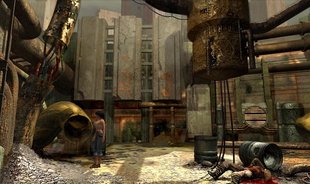
These memory blocks may resemble a survival horror game at first glance, with their pre-rendered backdrops and third-person tank controls. However, for the most part gameplay is far closer to standard adventure fare with situational puzzles that require recording clues and notes for use in dialogue trees and navigation later on. You’ll also need to collect items for trade and passage to different zones, some of which are found outside the memory block in which they are used, making backtracking between memories a necessity.
It’s not all conversation and puzzle solving, however. Sometimes you’ll be challenged with Quick Time Events in order to pass through an area safely. There is no combat, but there are also numerous platforming challenges forcing Druuna to leap over pits, run from enemies, or duck beneath hazardous machinery. There is constant pressure put on players to keep moving, lest they fall victim to one of the city’s mutants – or worse, the unhinged, predatory citizens looking to take advantage of others for their own gain.
Grave disease
It quickly becomes evident, however, that the in-game enemies are not what you should be most afraid of. Druuna is plagued by technical issues and sadistic design choices, making it nearly unplayable at times. Though quick and precise action is needed to see Druuna safely through the action sequences, unreliable controls often restrict her from moving if an obstacle is in her line of sight, even if it’s several feet away, resulting in her refusing to move until her path is readjusted (performing what has comically been referred to as her ‘duck waddle’).
Saving can be done mid-memory block, but due to Druuna’s fragile mental state, saving too often, being in a stressful situation, or staying in a memory block too long will cause her mental construct to crash, forcing players out. That, or the actual game will crash. Regardless, you should expect to replay large sections of the game multiple times.
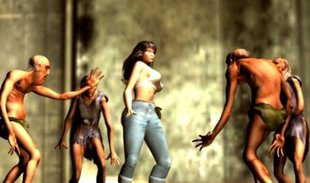
The story also differs considerably from the comic book on which it is based. A loose adaptation isn’t necessarily a bad thing, but Druuna’s graphic and sound design often fail to convey these tense scenes effectively. Characters in the game’s full-motion video sequences sometimes animate without … well, animation, getting stuck in a default pose with their arms extended and legs locked while they hop about the room as if they are puppets pulled by strings. Voice clips don’t always line up either, with one particularly funny example of a Priest being killed at the beginning of a scene, only to have their voice begin replaying for no reason near the end.
If there is a silver lining, it’s that the pre-rendered backgrounds are quite impressive. The city is a near-incomprehensible labyrinth of ruins. Flooded areas deep beneath the surface glow an eerie green, with teases of dangerous creatures breaking the surface of the stagnant water. Networks of claustrophobic, barely illuminated service corridors lead to horrifying landscapes of resin-like flesh covering degraded mechanical infrastructure. Serpieri was given ‘Original screenplay’ and ‘Supervision of direction’ credits in the game’s manual, suggesting he had some oversight of the art and story. It shows, with the rest of the design team doing a faithful job of bringing his expansive and decrepitly dangerous world to life.
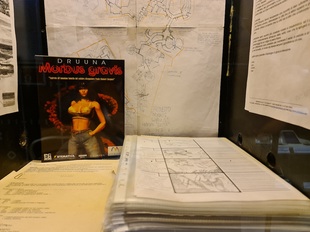
Druuna’s transition from the page to the screen has resulted in a slight caricaturing of her ample proportions compared to her on-paper model. She does begin the game in her trademark jeans and white shirt, making her identifiable to longtime fans. However, cheat codes allow players to swap out Druuna’s signature outfit for the likes of Wonder Woman and Lara Croft costumes should they feel like changing things up.
Unfortunately, the cheat code menu ends up being needed for more than cosmetic changes, as it’s likely you’ll need to use it in order to complete the game. Codes for illuminating dark areas or obtaining all the items are arguably necessary, especially if playing on a modern machine, where the game is all the more unstable, being subject to crashing to the desktop without warning.
The game’s music has received its share of praise, with Andrea Vialardi’s synthesized hymns and techno beats scoring the on-screen circumstances perfectly. It’s a shame there isn’t more opportunity to sit back and take the atmosphere in, as the pre-rendered backdrops coupled with the soundtrack make for a highly immersive, if unsettling, place to get lost.
Incurable
The critical reception for Druuna: Morbus Gravis was scathing, to say the least. Game Over awarded it a relatively favourable 59% while stating the game was little more than a series of uninteresting mazes. Far less charitable, GameSpot stated in their review, “It not only makes all the wrong moves, but it also finds new and innovative ways to make them.” They skewered the game, awarding it a 2.6/10, with the only thing close to praise being the game’s “vague semblance” of the comic book’s scenes imagined in 3D.
In a 2000 interview with Druuna.net, Serpieri was asked whether he was following the game’s development. He responded, “I think that the game can only be beneficial for the paper series, it's a complement. Any quality derivative product can only increase the character's notoriety.” To what degree Serpieri was involved with the game’s development is unknown, but the Artematica team credited him for “Supervision” in the game’s manual and thanked him as someone “from whom we also learnt a lot about life.” Based on the results, a legitimate attempt was made to create a worthy adaptation of the source material. Despite its multitude of problems, the framework for Druuna was sound, and whatever went wrong certainly wasn’t out of malice or disrespect for the property.
For obvious reasons, Druuna: Morbus Gravis is a hard game to recommend, but to those interested in this style of dark science fiction, it may hold a particular artistic appeal. Though it undeniably disappointed fans of the comic series, as well as newcomers simply hoping for a mature adventure gaming experience, the game’s visual direction is still a notable achievement. And technical issues aside, I can see what they were trying to accomplish had Artematica been able to fully realize their vision of a fragmented adventure where players could travel between the protagonist’s memories. Regrettably, there is no setting the technical issues aside, as they proved to be the fateful illness dooming the game largely to oblivion.
To no one’s surprise, this was Druuna’s first and only video game, and it has never been re-released digitally.










0 Comments
Want to join the discussion? Leave a comment as guest, sign in or register.
Leave a comment